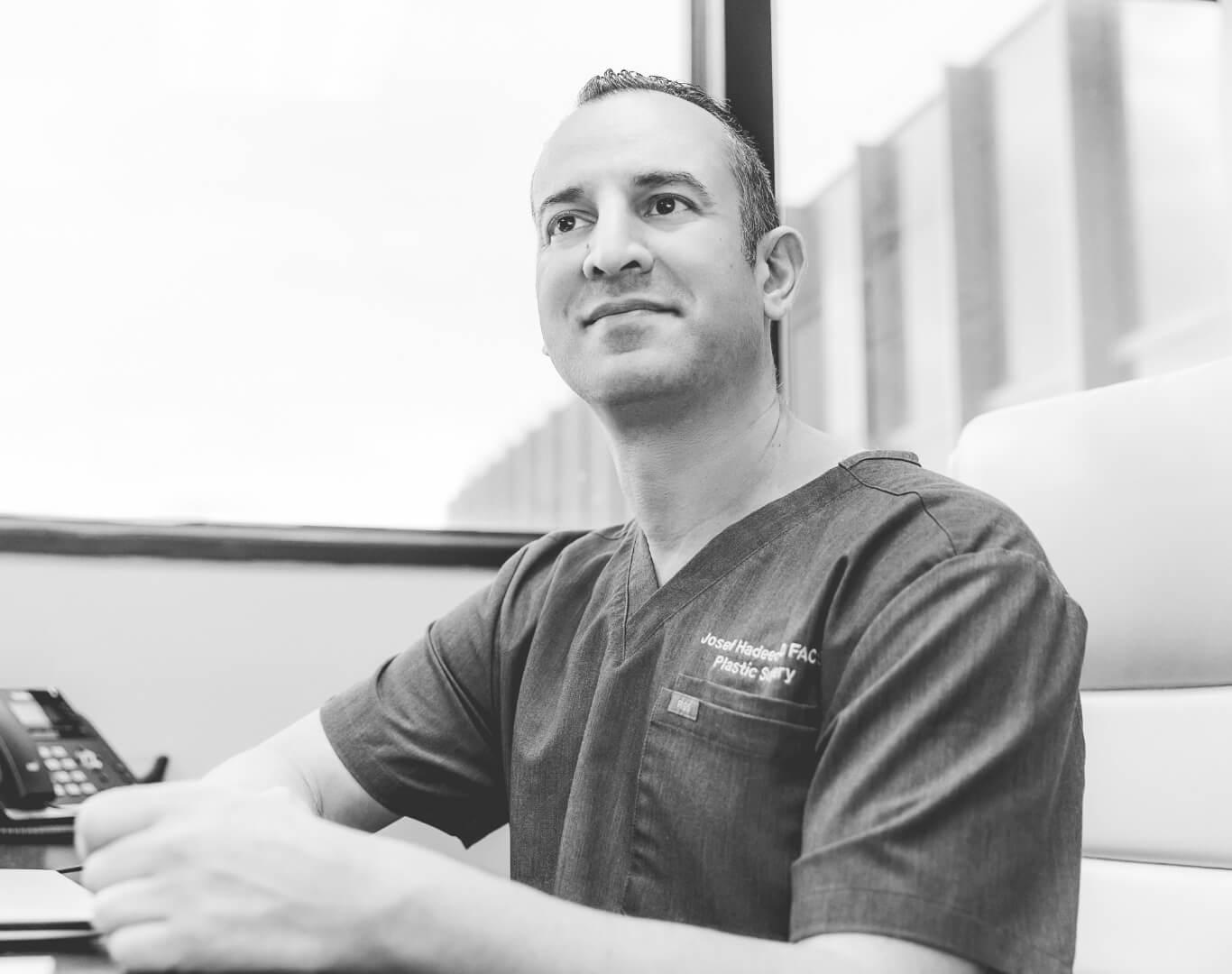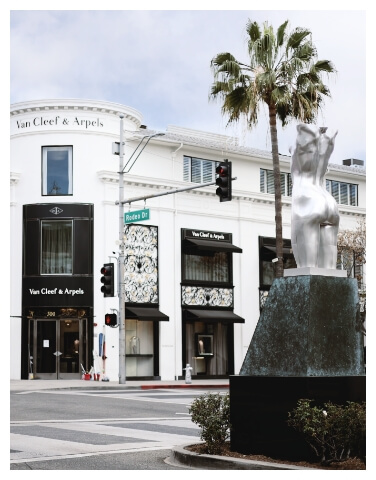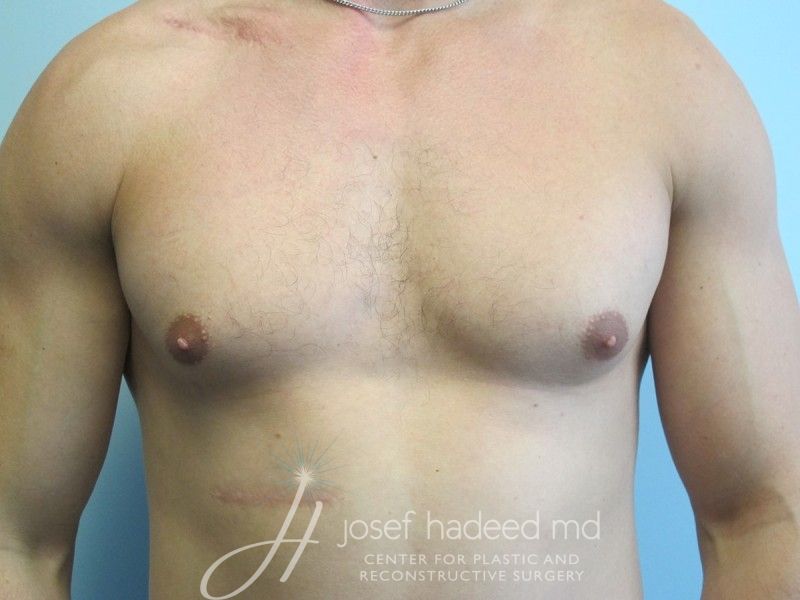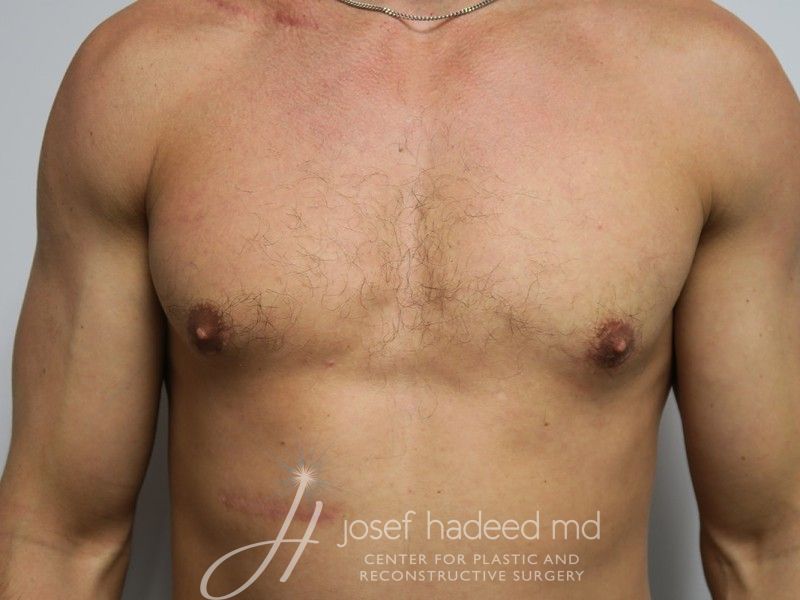What Is Gynecomastia?
Gynecomastia, also known as male breast enlargement, affects many men. In fact, as many as 70% of men will suffer from gynecomastia at some point in their lifetime.
There are several reasons men may have breast enlargement, including hormonal imbalances, alcohol consumption, marijuana use, certain medications, gyming to lose weight, liver disorders, and a history of cancer. Sometimes, however, there is no specific cause for enlarged male breasts.
Although gynecomastia does not cause any medical harm, it can be a source of embarrassment and directly affect a man’s self-confidence. Dr. Hadeed performs corrective surgery for gynecomastia or large male breasts, resulting in a more masculine chest that is firmer and flatter.
Dr. Hadeed focuses on individualized attention and care, providing education and guidance, and ultimately developing a plan for the most successful and safe outcome.
Schedule A ConsultationHow Is Gynecomastia Surgery Performed in Beverly Hills?
Gynecomastia surgery is usually performed as an outpatient procedure under general anesthesia.
Liposuction of Fat
Liposuction can achieve excellent results for men with gynecomastia caused mainly by excess fat. During the liposuction procedure, several tiny incisions are made in the chest. A small instrument is then inserted into the tissues of the chest to remove excess fat.
Removal of Glandular Tissue
Some men have excess glandular breast tissue in addition to excess fatty tissue deposits in the chest. In these cases, it may be necessary to make a small incision around the areola to remove the glandular breast tissue and use liposuction to remove the excess fat.
Excision of Excess Skin
After removing the excess fat and glandular tissue, excess skin that can no longer be stretched tautly over the chest may remain. If left alone, this may become flaps of loose, unsightly skin on the chest. Dr. Hadeed will remove this excess skin and ensure the remaining skin is tightened over the chest, resulting in a firmer, more youthful appearance.
Restoration of Upper Chest Volume
In some instances, men may desire further masculinization of their chest after gynecomastia surgery. Fat transfer to the chest can be performed by performing liposuction in another area of the body and reinjecting the purified fat into the upper part of the pectoralis muscle to create a stronger, more sculpted look.

See many examples of real patients before & after results
What Can I Expect During My Gynecomastia Surgery Recovery?
Most patients can expect to have bruising, swelling, and discomfort after surgery. You will wear a compression garment for the first six weeks after surgery to help control swelling and support the chest’s new contour.
Recovery time will also vary depending on the extent of your surgery. If you only need liposuction to correct your gynecomastia, you can typically return to work and your exercise routine about one week after surgery. If your gynecomastia procedure requires the removal of excess glandular tissue, your recovery time is a bit longer—usually one to two weeks. Dr. Hadeed will give you specific instructions regarding the dos and don’ts of your recovery.
When Will I See My Gynecomastia Surgery Results?
The results of your male breast reduction surgery are almost immediate and will become more apparent as the bruising and swelling subside.
Following your male breast reduction, you will see a firmer, tighter, and more masculine-looking chest and gain a restored sense of self-confidence. However, you will still have some minor bruising and swelling. While the bruising should resolve quickly, the swelling takes longer to dissipate completely. It’s important to continue wearing your compression garment as directed, as it helps reduce swelling and shape the new contour of your chest.
The final results from your gynecomastia surgery will be visible three to six months after your procedure, giving you a restored sense of self-confidence.
Gynecomastia surgery results are considered permanent as long as you maintain a healthy, stable weight and avoid medications and substances that contribute to the development of gynecomastia.
Gynecomastia Surgery FAQ
What causes gynecomastia?
Gynecomastia is often caused by an imbalance in your hormones when your estrogen levels (female hormones) rise and testosterone levels (male hormones) decrease. Hormonal imbalance usually happens during puberty and around age 50 and above. Many times, gynecomastia will go away once your hormones balance out.
Other reasons you may develop gynecomastia include the following:
- A side effect of certain medications, such as treatments for cancer, depression, ulcers, and cardiovascular issues
- Use of anabolic steroids or recreational drugs such as marijuana or heroin
- A result of some medical conditions, such as thyroid disorders, liver or kidney disease, and certain cancers
If your gynecomastia affects your self-confidence, seeing Dr. Hadeed for a consultation and understanding your surgery options will help you decide the best course of action.
What are the symptoms of gynecomastia?
Besides the appearance of larger, more feminine breasts, the main symptom of gynecomastia is a lump under your nipple that feels hard or tender. Additionally, while gynecomastia usually affects both sides of a man’s chest, that is not always the case. If you notice that your chest appears asymmetric or that one breast looks larger than the other, you may have gynecomastia. It’s best to see a physician for an accurate diagnosis if you notice any changes in your chest.
Am I a good candidate for gynecomastia surgery?
The best candidates for male breast reduction surgery are men in overall good health and close to their ideal body weight. Significant fluctuations in your weight after surgery can affect your results, so you should also be committed to maintaining the new contours of your chest.
Another consideration is age: gynecomastia can affect men of any age, but it is often an embarrassing part of puberty and the teen years. However, you should wait until at least age 20 to undergo surgery so your hormones have time to stabilize. In many cases, your gynecomastia may resolve on its own. However, getting surgery too early may result in needing additional surgery later.
Is gynecomastia surgery painful?
Gynecomastia surgery is performed using a general anesthetic, so the procedure itself is not painful. After your surgery, you may experience mild to moderate pain and swelling during the initial recovery period. Depending on the extent of your surgery, you may also experience a feeling of tightness or loss of sensation. Any discomfort may be treated with prescription medications and other recommended aftercare.
What is discussed during my gynecomastia consultation?
During your initial consultation, Dr. Hadeed will evaluate your physique and overall health and discuss your medical history and aesthetic goals. You need to reveal any medical conditions or medications you take that may complicate the surgery or recovery. You may be asked to refrain from smoking or vaping and taking blood-thinning medicines, such as aspirin, ibuprofen, NSAIDs, and herbal supplements, for at least two weeks before your gynecomastia surgery. He will use this information to determine if you are a candidate for a combination procedure and work with you to create a treatment plan unique to your desired outcome.
What are the risks associated with gynecomastia surgery?
While Dr. Hadeed does everything possible to minimize the danger of complications, like all surgical procedures, gynecomastia surgery does come with associated risks. Gynecomastia surgery procedures, in particular, may carry the risk of:
- Bleeding
- Adverse reactions to the anesthesia
- Unfavorable scarring
- Numbness or other changes in skin sensation
- Persistent pain
- Poor wound healing
Does gynecomastia surgery leave scars?
As with any surgery, male breast reduction will leave scars from the small incisions. However, Dr. Hadeed will do his best to make the incisions as small as possible and place them in inconspicuous locations. The resulting scars will fade over time. Keeping the scars out of the sun and caring for them with scar gels, creams, or silicone scar strips will also help them fade quickly.
How much does gynecomastia surgery cost in Beverly Hills, CA?
The cost of gynecomastia surgery in Beverly Hills, CA, varies depending on the specifications of your treatment and whether it is combined with other procedures. For example, removing glandular tissue combined with skin excision and liposuction will cost more than liposuction alone. Additionally, you may decide to add other body contouring procedures to your gynecomastia surgery.
The cost will also depend on the fees associated with surgery, including anesthesia fees and the expenses related to the hospital or surgical facility where your procedure is performed. Dr. Hadeed will give you a more accurate cost estimate after your consultation and, if necessary, discuss financing options.
Can I benefit from gynecomastia surgery after a significant weight loss?
While gynecomastia isn’t directly caused by being overweight, obesity can increase excess breast tissue and make the condition worse. Additionally, losing a significant amount of weight in other parts of your body can make your gynecomastia more noticeable.
Removing excess skin, breast tissue, and fat after significant weight loss can give your chest a more sculpted and masculine contour, restoring your confidence and making you proud to show off your weight loss results.
Will my gynecomastia surgery results be permanent?
While the removed fat and glandular tissue will not return, this surgery does not prevent additional weight gain or stop the natural aging process of the chest. Some patients may choose to get a second gynecomastia surgery or chest contouring procedure if the effects of the first treatment fade.
At what age should you get gynecomastia surgery?
Gynecomastia is common, usually peaking at two points in a man’s life: adolescence and then again later in life. There are no restrictions regarding age (since candidacy depends more on breast condition). Most patients choose to get gynecomastia surgery either after puberty or after middle age.
Is gynecomastia associated with breast cancer?
Gynecomastia is usually a benign condition, and instances of male breast cancer are very rare. However, besides being a cosmetic issue, gynecomastia can also be a symptom of other underlying health problems. While that isn’t always the case, it is still important to see a doctor or plastic surgeon if you notice an unexplained lump in your breast.
What is glandular tissue, and why does it overdevelop?
Glandular tissue is a grouping of cells designed to help excrete substances from your body (think sweat glands). Glandular breast tissue is present in men, but men don’t usually have the hormone signals that women do to increase the growth of that tissue. However, when your hormones are out of balance, an overabundance of estrogen can cause the glandular tissue to grow more than it should. The result is gynecomastia.
Can gynecomastia surgery be combined with other procedures?
Gynecomastia surgery can be performed alone or in combination with additional body contouring procedures, including:


Beverly Hills, California
9454 Wilshire Blvd
Suite 710
Beverly Hills, CA 90212




